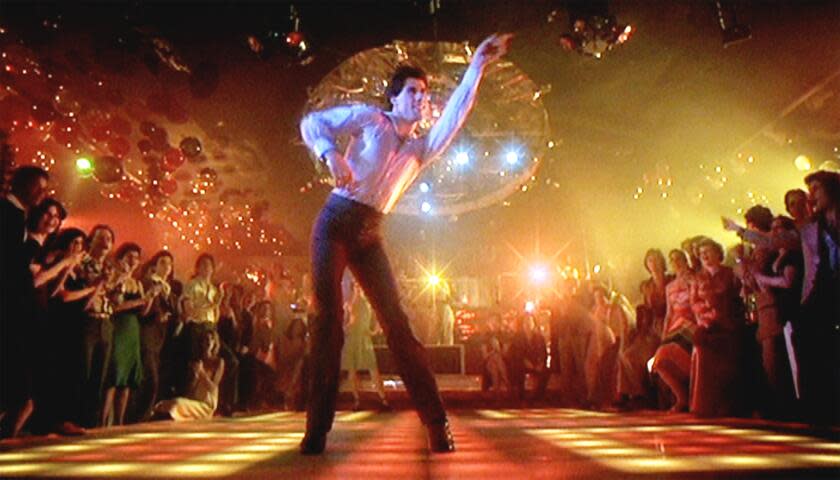Opinion: The dance floor from 'Saturday Night Fever'? It's stayin' alive

There’s that floor again, that famous floor — geometric, primary colors, flashing in the perpetuity of pop culture memory, an icon of the long-ago disco era. Surely you’ve seen it, pulsing beneath John Travolta’s platform shoes in the 1977 film “Saturday Night Fever.”
It’s up for auction in Los Angeles later this month along with other items of Hollywood lore, including the Ark of the Covenant prop from “Raiders of the Lost Ark.” The auction is a joint project of Julien’s Auctions and Turner Classic Movies (on which ads have been relentless). At the moment, bidding for the dance floor is at $50,000; the estimated sale price is $200,000 to $300,000.
Read more: Op-Ed: With Pearl Harbor memories still raw, Hollywood told the story through an unexpected lens
This news caught my eye because I haven’t just seen that flashy floor. I know it personally. I met it in the years after the movie, while it lived semi-obscurely in the club featured in the film, 2001 Odyssey, in a Brooklyn neighborhood called Bay Ridge.
Who says Hollywood legends don’t have second and even third lives?
I played bass in a high school band called the Zones, and we rented out the club to play. We’d charge $4 and give $1 to the house — a tidy profit. We packed the place.
We played a mix of original songs and contemporary covers — “Message in a Bottle” by the Police and “Pulling Mussels (From the Shell)” by Squeeze always got a big response. About two or three songs into our set, the guy behind the bar would switch on that floor, and any last holdouts would come out and dance. The plane would take flight. Those flashing lights really had an effect.
We worked hard at the Zones, harder than we did at our classwork (at least I did). There were five of us, five heads of greasy hair that were impressive until compared with some of the ginormous ’80s coifs bouncing up and down on the dance floor. Futures as famous musicians clearly beckoned.
You’d think reading about the auction would take me back to those days and get me thinking: What ever happened to those guys? But there’s no need for that because I saw them a few weeks ago. I know exactly what happened to them.
It started last year with Dave’s idea — after 40 years, to reunite and record our originals again, this time with modern technology that will eliminate the tape hiss, feedback and other flaws from the recordings we made in 1983 and 1984.
Dave played keyboards, and it was his playing, I think, that most set us apart. His Gibson G-101 added a layer of shrieking warm chords atop and between the guitars, bass and drums. He was hard to read in rehearsal. If he didn’t like a new song, for example, he’d never say so. He’d just play with minimal enthusiasm or, if he really didn’t like it, simply get up and walk out of the room.
But in the emails and texts that flew around about the reunion, he was not hard to read at all: He wanted us to get together, he booked the studio time, and he pushed until we all agreed.
Matt, the guitar player, came from North Carolina. Steve and Jamal, drummer and drummer-vocalist (yes, we had two drummers) came from New Jersey. I was the only one who still lived in Brooklyn.
The hair was pretty much all gone. Dave still plays occasionally with the ska band the Toasters, and Jamal is always hard at work recording this or that project, but really, those are the only two with toeholds in music. I play bass in the basement for fun (when I’m not watching Turner Classic Movies), but it’s my son’s bass.
The auction site says that floor was built for $15,000 for the film and lived in 2001 Odyssey until the place closed in 2005. It is 24 feet by 16 feet and still works. It looks like a modern, space-age thing in “Saturday Night Fever,” but closeup photos show it to be a relatively primitive, analog affair, built of wood, with colored light bulbs beneath acrylic panels. Bidding ends June 16.
The Zones were an analog affair, too. And we’ve traveled in time as that floor has — marriages, divorces and near-divorces, health issues, career successes and lost jobs, a total of eight children, deaths of parents and those even closer to us. No grandchildren — yet
We took our places in the studio at our first meeting last year and plugged in. We’d had some Zoom meetings to plan it out, but this was the moment of truth. Sonny, the engineer, was ready to get it all down — digitally.
It didn’t happen right away, but it happened. Maybe on the second song, maybe the third. It was like that moment on the runway when you are suddenly, magically airborne. Forty years on, we were still a band. Jamal always laughed loudly from his kit when we sounded good, when it all clicked and we were in the pocket, and now he laughed long and hard. And Dave never walked out of the room. We’ve met repeatedly since to fine-tune.
We’ve had our ups and downs, and no one is a rock star, but we nailed those songs. We are still going strong. Just like that famous floor.
Wendell Jamieson, a communications and political consultant, spent 18 years at the New York Times, where he wrote occasionally on music and film.
This story originally appeared in Los Angeles Times.


